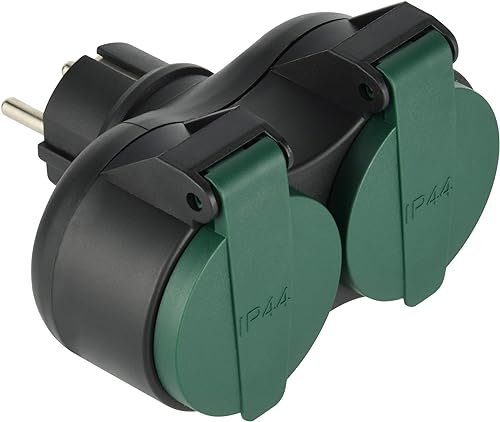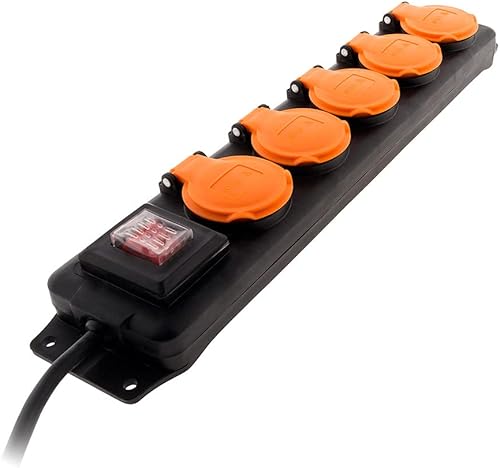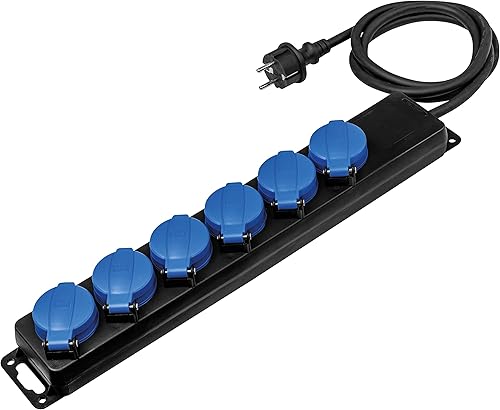How to Choose a Waterproof Power Strip in 2025? Guide and Comparison
Waterproof power strips have become essential in many homes and workspaces, providing not only extra plug options but also reliable protection against external elements like water and moisture. Whether for outdoor use, in a kitchen, or in a bathroom, choosing the right waterproof power strip ensures safety and performance.
Our TOP 3
Electraline

Pros
- High quality
- Waterproof functionality
- Double socket
- Good value for money
Cons
- None notable
Specs
Zenitech

Pros
- 5-socket power strip
- Integrated switch
- Good for damp exteriors
- Handy for decorations
Cons
- Some concerns about waterproofness
Specs
Schwabe

Pros
- 6 sockets
- Sturdy and practical
- Excellent waterproofness
- Good value for money
Cons
- Potential issue with defective sockets
Specs
Selection Criteria
IP Protection Level
The IP (Ingress Protection) rating is an essential criterion that determines a power strip's resistance to water and dust. For example, an IP44 rating offers protection against water splashes, while IP67 allows temporary immersion. Choose a rating suitable for the intended usage environment.
Load Capacity
Before purchasing, consider the power strip's load capacity. Ensure it can support all of your electrical equipment by checking the maximum in amps or watts, usually indicated on the product. A 16A power strip is common and supports up to 3680 watts.
Number of Sockets and Configuration
Assess your needs in terms of the number of connections. Some power strips offer not only standard sockets but also USB ports, which can be useful for charging mobile devices. Choose a configuration that matches your daily use.
Cable Length
The cable length can be crucial depending on where you plan to install the power strip. Longer cables offer increased flexibility but ensure they do not cause excessive clutter.
Common Mistakes
Neglecting the IP Protection Level
A common mistake is ignoring the IP rating. Using a power strip with an inadequate IP rating for a damp environment can lead to electrical failures and potentially material damage.
Overloading the Power Strip
Plugging in more devices than the power strip can support may lead to overheating or even fire hazards. Always adhere to the load specifications.
Choosing an Inappropriate Size
Consider the available space for your power strip. An overly bulky power strip in a small area can be challenging to install securely.
Comparison of our 3 favorite products
Electraline- Double waterproof socket ideal for outdoor use

The Electraline Biplite is designed to withstand outdoor environments thanks to its IP44 protection, offering a handy double socket that is water-resistant.
Pros
- High quality
- Waterproof functionality
- Handy double socket
- Good value for money
Cons
- None notable
Zenitech- Power strip with waterproof protection and integrated switch

The Zenitech block provides IP44 waterproofing with 5 sockets, an integrated switch, and a long cable making it ideal for garden or outdoor use.
Pros
- 5-socket power strip
- Integrated switch
- Good for damp exteriors
- Handy for decorations
Cons
- Some concerns about waterproofness
Schwabe- 6 sockets for outdoor applications with long durability

The Schwabe power strip is designed for outdoor applications, offering 6 sockets with high waterproofing and a robust design to withstand tough conditions.
Pros
- 6 sockets
- Sturdy and practical
- Excellent waterproofness
- Good value for money
Cons
- Potential issue with defective sockets
Practical Tips
- Check the Integrated Switch: A power strip with an on/off switch allows you to reduce energy consumption and protect devices by cutting off power when not in use.
- Opt for Robust Materials: A reinforced plastic construction is often more durable against impacts and moisture.
- Correct Installation: Ensure the power strip is installed at a safe distance from direct water and the cable is properly secured to avoid twists that could damage it.